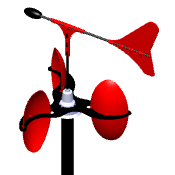Comparing Digital and Mechanical Anemometers: Which is Right for You?
Comparing Digital and Mechanical Anemometers: Which is Right for You?
Blog Article
Exploring the Features and Benefits of Anemometers for Weather Condition Lovers and Specialists
Anemometers stand as crucial tools in the realm of weather condition surveillance, accommodating both lovers and skilled professionals alike. These gadgets use a home window into the vibrant globe of wind patterns and speeds, giving important data for atmospheric evaluation and forecasting. From mug anemometers to sonic anemometers, each kind brings its special collection of advantages and applications, losing light on various aspects of atmospheric conditions. As we look into the functions and advantages of anemometers, a deeper understanding emerges not only of dominating weather condition sensations however additionally of the wider implications for sectors like wind power manufacturing and environmental study.
Relevance of Anemometers in Weather Condition Monitoring
Anemometers play a crucial role in weather condition tracking by giving accurate measurements of wind speed, helping in forecasting and understanding weather condition patterns. These tools, varying from typical cup anemometers to modern ultrasonic anemometers, are vital for meteorologists, researchers, and weather condition lovers alike.

Kinds Of Anemometers and Their Applications
With the essential role anemometers play in climate surveillance and projecting, comprehending the various kinds of these tools and their applications ends up being necessary for experts and enthusiasts in the area. One of the most typical types of anemometers consist of mug anemometers, vane anemometers, hot-wire anemometers, and ultrasonic anemometers. Cup anemometers contain three or four mugs installed on horizontal arms that revolve with the wind, determining its speed. Vane anemometers, on the various other hand, utilize a freely revolving vane to line up with the wind direction, giving both wind rate and instructions dimensions. Hot-wire anemometers operate based upon the concept of convective heat transfer, where the cooling result of the air flow is measured to figure out wind speed. Ultrasonic anemometers make use of ultrasonic acoustic wave to compute wind rate and direction properly.
Cup anemometers are suitable and robust for basic weather surveillance, while vane anemometers are favored for directional measurements. Ultrasonic anemometers are non-intrusive and use high precision, usually made use of in study and specialized weather monitoring applications.
Advantages of Using Anemometers in Forecasting
In meteorology, the usage of anemometers provides indispensable advantages for enhancing the precision of weather forecasting. Anemometers determine wind speed and direction, offering essential data for predicting climate patterns. By incorporating wind data into projecting versions, meteorologists can better understand the movement of weather systems, prepare for modifications in climatic conditions, and issue more precise forecasts.
Moreover, anemometers play link a crucial function in assessing potential weather hazards. Checking wind rates aids forecasters forecast severe weather occasions such as cyclones, twisters, and wintertime tornados with better accuracy. This very early caution system makes it possible for authorities to issue timely signals and execute required precaution, minimizing the risks to life and property.
Additionally, anemometers help in optimizing eco-friendly power production. By assessing wind patterns, meteorologists can determine suitable places for wind ranches and forecast power result, adding to the efficient generation of wind power.

Anemometers in Wind Energy Production
Provided the critical duty anemometers play in supplying precise wind data for weather condition projecting and risk analysis, their significance reaches the world of wind power manufacturing. Anemometers are necessary instruments in the area of wind power, where the measurement of wind rate and instructions is vital for figuring out the usefulness and performance of wind turbine installations. By properly measuring wind speeds at varying heights, anemometers assist optimize the placement and design of wind generators to make best use of energy result.
In wind ranches, anemometers are purposefully put to gather real-time wind data that is made use of to evaluate the prospective power manufacturing of a site. This data is crucial in establishing the financial viability of wind energy projects and in projecting power generation to ensure grid stability. In addition, anemometers help in checking wind problems to optimize turbine performance, prevent damages from high winds, and guarantee the safety of employees working in the location of wind generators.
Enhancing Weather Condition Recognizing With Anemometers

Anemometers play a key function in enhancing our understanding of microclimates. These local climate conditions can differ substantially from wider regional forecasts, making it important to have precise data for specific locations. anemometer. By purposefully positioning anemometers in different places, researchers can collect thorough details on exactly how wind behaves in various surfaces, metropolitan environments, or bodies of water
Moreover, anemometers add to enhancing weather condition forecasting models by offering real-time information on wind habits. This info is particularly useful for anticipating severe weather occasions, enhancing agricultural techniques, and supporting industries like air travel and maritime navigation. Generally, anemometers are indispensable instruments that enable us to delve much deeper into the complexities of climate systems, ultimately leading to even more better-informed choices and accurate forecasts.
Final Thought
In conclusion, anemometers play an important role in weather condition surveillance and forecasting by determining wind rate and instructions. Anemometers also have applications in wind check out this site power manufacturing, additional anemometer highlighting their importance in both weather forecasting and sustainable energy industries.
From mug anemometers to sonic anemometers, each type brings its one-of-a-kind set of applications and benefits, shedding light on numerous aspects of climatic conditions. These instruments, ranging from conventional mug anemometers to modern-day ultrasonic anemometers, are vital for meteorologists, scientists, and climate enthusiasts alike. The most typical types of anemometers consist of cup anemometers, vane anemometers, hot-wire anemometers, and ultrasonic anemometers. Cup anemometers are durable and ideal for basic weather monitoring, while vane anemometers are preferred for directional dimensions. Anemometers are important instruments in the area of wind power, where the dimension of wind rate and instructions is crucial for identifying the expediency and efficiency of wind turbine installments.
Report this page